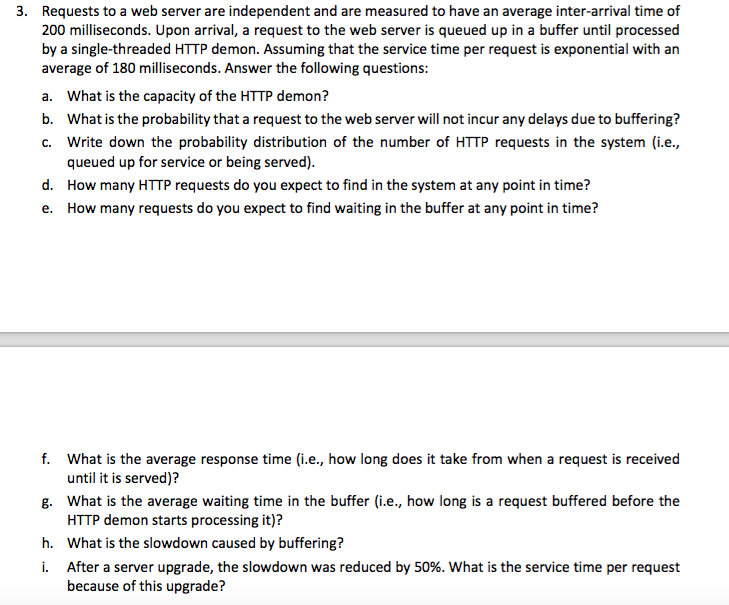
3. Requests to a web server are independent and are measured to have an average inter-arrival time of 200 milliseconds. Upon arrival, a request to the web server is queued up in a buffer until processed by a single-threaded HTTP demon. Assuming that the service time per request is exponential with an average of 180 milliseconds. Answer the following questions: a. What is the capacity of the HTTP demon? b. What is the probability that a request to the web server will not incur any delays due to buffering? c. Write down the probability distribution of the number of HTTP requests in the system (i.e., queued up for service or being served). How many HTTP requests do you expect to find in the system at any point in time? How many requests do you expect to find waiting in the buffer at any point in time? d. e. f. What is the average response time (i.e., how long does it take from when a request is received until it is served)? g. What is the average waiting time in the buffer (i.e., how long is a request buffered before the HTTP demon starts processing it)? What is the slowdown caused by buffering? After a server upgrade, the slowdown was reduced by 50%, what is the service time per request because of this upgrade? h. i. 3. Requests to a web server are independent and are measured to have an average inter-arrival time of 200 milliseconds. Upon arrival, a request to the web server is queued up in a buffer until processed by a single-threaded HTTP demon. Assuming that the service time per request is exponential with an average of 180 milliseconds. Answer the following questions: a. What is the capacity of the HTTP demon? b. What is the probability that a request to the web server will not incur any delays due to buffering? c. Write down the probability distribution of the number of HTTP requests in the system (i.e., queued up for service or being served). How many HTTP requests do you expect to find in the system at any point in time? How many requests do you expect to find waiting in the buffer at any point in time? d. e. f. What is the average response time (i.e., how long does it take from when a request is received until it is served)? g. What is the average waiting time in the buffer (i.e., how long is a request buffered before the HTTP demon starts processing it)? What is the slowdown caused by buffering? After a server upgrade, the slowdown was reduced by 50%, what is the service time per request because of this upgrade? h







